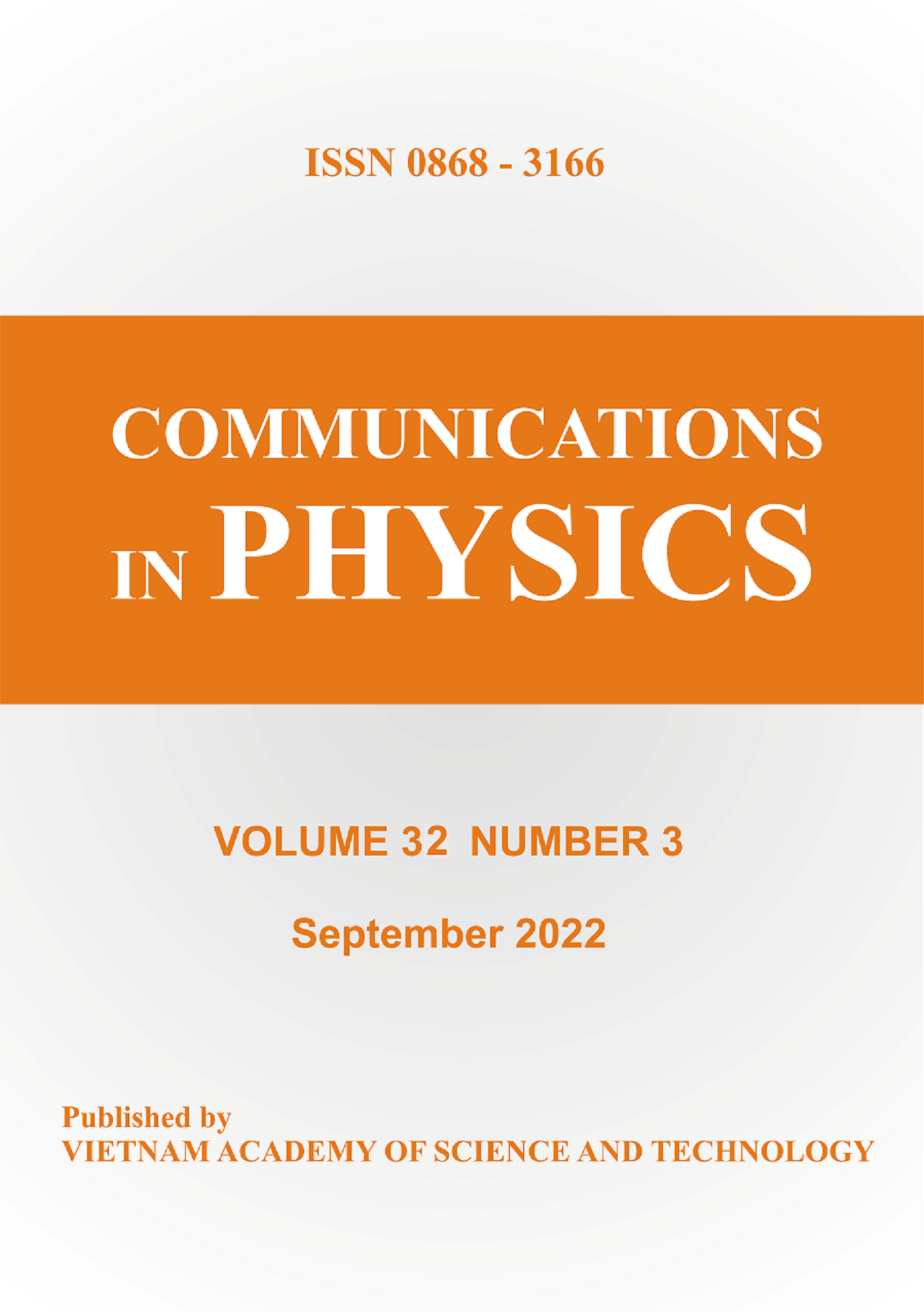Development of Novel 3d Printable Graphene-based Composite Towards Fabrication of Thin Film Electrode Material
Author affiliations
DOI:
https://doi.org/10.15625/0868-3166/30/4/15447Keywords:
3D printable ink, graphene composite, polyvinyl alcohol, ascorbic acid, electrode materialAbstract
Graphene/polymer composite thin film electrodes have many important applications, but the fabrication of these electrodes is often difficult because of poor processability of graphene. This paper presents the primary results on using 3D printing technique for thin film electrode preparation from graphene-based composite ink. The printing ink was synthesized from graphene oxide (GO), polyvinyl alcohol (PVA) as a binder and stabilizer, and ascorbic acid (AA) as a reducing agent. The measured zeta potential value showed that PVA can make GO ink more stable, the absolute value of zeta potential increased from 10.1 mV (without PVA) to 31.4 mV (with 12 wt. % PVA). The thin film electrodes can be easily printed using GO/PVA/AA composite ink, and obtained voltammograms recorded on the surface of these electrodes in 5 mM K3[Fe(CN)6]/K4[Fe(CN)6] solution clearly indicated the GO reduction by AA. The best electrochemical properties of printed electrodes were founded in the case of composite ink with wt/wt ratio GO:PVA:AA = 80:12:8. The cyclic voltammetric results demonstrated the linear dependence of the anodic and cathodic signals of redox couple [Fe(CN)6]4-/K3[Fe(CN)6]3- with the square root of scan rate, indicating a reversible redox reaction on the electrode surface. The thin films printed from GO/PVA/AA composite ink can be used as electrode material for diverse applications in electrochemistry.Downloads
Metrics
References
[1] Wongbong Choi and Jo-won Lee, Graphene: synthesis and applications, CRC Press, 2011.
![]()
[2] M. Pumera, A. Ambrosi, A. Bonanni, E. L. K. Chng and H. I. Poh, Trends Analyst. Chem. 29 (2010) 954.
DOI: https://doi.org/10.1016/j.trac.2010.05.011
![]()
[3] Maher F. El-Kady, Richard B. Kaner, Nature Communications 4 (2013) 1475.
DOI: https://doi.org/10.1038/ncomms2446
![]()
[4] M. Y. Yen, C. K. Hsieh, C. C. Teng, M. C. Hsiao, P. I. Liu, C. C. M. Ma, M. C. Tsai, C. H. Tsai, Y. R. Lin
![]()
and T. Y. Chou , RSC Adv. 2 (2012) 2725
DOI: https://doi.org/10.1039/c2ra00970f
![]()
[5] Cao T. Thanh, Nguyen H. Binh, Nguyen V. Tu, Vu T. Thu, M. Bayle, M. Paillet, J. L. Sauvajol, Phan B. Thang,
![]()
Tran D. Lam and Phan N. Minh, Sens. Actuators B Chem. 260 (2018) 78.
DOI: https://doi.org/10.1016/j.snb.2017.12.191
![]()
[6] Shannon M. Notley, Drew R. Evans, Adv. Colloid Interface Sci. 209 (2014) 196.
DOI: https://doi.org/10.1016/j.cis.2014.04.006
![]()
[7] T. Dung Nguyen, T. T. Huyen Dang, Hoang Thai, L. Huy Nguyen, D. Lam Tran, B. Piro and M. C. Pham,
![]()
Electroanalysis 28 (2016) 1907.
![]()
[8] F. Zhou, S. Han, Q. Qian and Y. Zhu, Chem. Phys. Lett. 728 (2019) 6.
DOI: https://doi.org/10.1016/j.cplett.2019.04.062
![]()
[9] Hoang T. Dung, Ngo T. Dung, Trinh Q. Dung, Doan T. Tung, Nguyen T. Yen, Le T. T. Tam, Tran V. Thu, Phan
![]()
N. Hong and Le T. Lu, Vietnam J. Sci. Tech. 56 (2018) 574.
DOI: https://doi.org/10.1002/vjch.201800050
![]()
[10] Doan T. Tung, Le T.T Tam, Hoang T. Dung, Ngo T. Dung, Hoang T. Ha, Nguyen T. Dung, Thai Hoang, Tran
![]()
D. Lam, Dang T. Chien, Phan N. Hong, Phan N. Minh, Nguyen V. Quynh and Le T. Lu, J. Electron. Mater. 49
![]()
[11] F. Zhang, M. Wei, V.V. Viswanathan, B. Swart, Y. Shao, Nano Energy 40 (2017) 418.
DOI: https://doi.org/10.1016/j.nanoen.2017.08.037
![]()
[12] V. Dua, S. P. Surwade, S. Ammu, S. R. Agnihotra, S. Jain, K. E. Roberts, S. Park, R. S. Ruoff and S. K. Manohar,
![]()
Angewandte Chemie International Edition 122 (2010) 2154.
![]()
[13] L. Baptista-Pires, A. Escosura-Muniz, M. Balsells, J. C. Zuaznabar-Gardona and A. Merkoci, Electrochem. Commun. 98 (2019) 6.
DOI: https://doi.org/10.1016/j.elecom.2018.11.001
![]()
[14] C. Zhu, T. Liu, F. Qian, T. Y. Han, E. B. Duoss, J. D. Kuntz, C. M. Spadaccini, M. A. Worsley, Y. Li, Nano
![]()
[15] E. García‐Tuñon, S. Barg, J. Franco, R. Bell, S. Eslava, E. D'Elia, F. Guitian, E. Saiz, Adv. Mate. 27 (2015) 1688.
DOI: https://doi.org/10.1002/adma.201405046
![]()
[16] Q. Ran, S. Wu and J. Chen, Polym. Plast. Technol. Eng. 46 (2007) 1117.
DOI: https://doi.org/10.1080/03602550701557944
![]()
[17] X. Zhao, Q. Zhang, D. Chen and P. Lu, Macromolecules 43 (2010) 2357.
DOI: https://doi.org/10.1021/ma902862u
![]()
[18] P.B. Pawar, S. Shukla and S. Saxena, J. Power Sources 321 (2016) 102.
DOI: https://doi.org/10.1016/j.jpowsour.2016.04.127
![]()
[19] D. C. Marcano, D. V. Kosynkin, J. M. Berlin, A. Sinitskii, Z. Sun, A. Slesarev, L. B. Alemany, W. Lu and J. M.
![]()
Tour, ACS Nano 4 (2010) 4806.
DOI: https://doi.org/10.1021/nn1006368
![]()
[20] J. Zhang, H. Yang, G. Shen, P. Cheng, J. Zhang and S. Guo, Chem. Commun. 46 (2010) 1112.
DOI: https://doi.org/10.1039/B917705A
![]()
[21] I. Svancara, K. Kalcher, A. Walcarius and K. Vytras, Analysis with Carbon Paste Electrodes, CRS Press, Francis
![]()
[22] Fritz Scholz (Ed.), Electroanalytical methods: guide to experiments and applications, Springer-Verlag Berlin
![]()
Downloads
Published
How to Cite
Issue
Section
License
Authors who publish with CIP agree with the following terms:- The manuscript is not under consideration for publication elsewhere. When a manuscript is accepted for publication, the author agrees to automatic transfer of the copyright to the editorial office.
- The manuscript should not be published elsewhere in any language without the consent of the copyright holders. Authors have the right to enter into separate, additional contractual arrangements for the non-exclusive distribution of the journal’s published version of their work (e.g., post it to an institutional repository or publish it in a book), with an acknowledgement of its initial publication in this journal.
- Authors are encouraged to post their work online (e.g., in institutional repositories or on their websites) prior to or during the submission process, as it can lead to productive exchanges or/and greater number of citation to the to-be-published work (See The Effect of Open Access).
Accepted 13-11-2020
Published 14-11-2020













